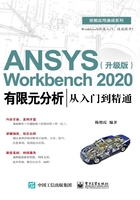
4.1 ANSYS Workbench 2020后处理
ANSYS Workbench 2020平台的后处理包括以下几部分内容:查看结果、显示结果(Scope Results)、输出结果、坐标系和方向解、结果组合(Solution Combinations)、应力奇点(Stress Singularities)、误差估计、收敛状况等。
4.1.1 查看结果
当选择一个结果选项时,Result(结果)选项卡就会显示该结果所要表达的内容,如图4-1所示。

图4-1 Result(结果)选项卡
缩放比例:对于结构分析(静态、模态、屈曲分析等),模型的变形情况将发生变化。在默认状态下,为了更清楚地显示结构的变化,比例系数会被自动放大。用户可以将结构改变为非变形或实际变形情况,默认的比例因子如图4-2所示。同时用户可以自己输入比例因子,如图4-3所示。

图4-2 默认的比例因子

图4-3 输入比例因子
显示方式:Geometry按钮可以控制云图的显示方式,共有4种可供选择的选项。
(1)Exterior:默认的显示方式且是最常用的方式,如图4-4所示。
(2)IsoSurfaces:对于显示相同的值域是非常有用的,如图4-5所示。
(3)Capped IsoSurfaces:指删除了模型的一部分之后的显示结果,并且删除的部分是可变的,高于或低于某个指定值的部分会被删除,如图4-6和图4-7所示。

图4-4 Exterior方式

图4-5 IsoSurfaces方式

图4-6 Capped IsoSurfaces方式1

图4-7 Capped IsoSurfaces方式2
(4)Section Planes:允许用户真实地切模型,需要先创建一个界面,然后显示剩余部分的云图,如图4-8所示。

图4-8 Section Planes方式
色条设置:Contours按钮可以控制模型的云图显示方式。
(1)Smooth Contours:光滑显示云图,颜色变化过渡光滑,如图4-9所示。
(2)Contour Bands:云图显示有明显的色带区域,如图4-10所示。

图4-9 Smooth Contours方式

图4-10 Contour Bands方式
(3)Isolines:以模型等值线的方式显示,如图4-11所示。
(4)Solid Fill:不在模型上显示云图,如图4-12所示。

图4-11 Isolines方式

图4-12 Solid Fill方式
外形显示:Edges按钮允许用户显示未变形的模型或划分网格的模型。
(1)No WireFrame:不显示几何轮廓线,如图4-13所示。
(2)Show Undeformed WireFrame:显示未变形的几何轮廓线,如图4-14所示。

图4-13 No WireFrame方式

图4-14 Show Undeformed WireFrame方式
(3)Show Undeformed Model:显示未变形的模型,如图4-15所示。
(4)Show Elements:显示单元,如图4-16所示。

图4-15 Show Undeformed Model方式

图4-16 Show Elements方式
最大值、最小值与刺探工具:单击相应按钮,在图形中会显示最大值、最小值和刺探位置的数值。
4.1.2 显示结果
在后处理过程中,读者可以指定输出的结果,以静力计算为例,软件默认的输出结果包括如图4-17所示的一些类型,其他分析结果请读者自行查看,这里不再赘述。

图4-17 后处理的输出结果类型
4.1.3 显示变形
在Workbench Mechanical的计算结果中,可以显示模型的变形量,主要包括![]() 及
及![]() 分析命令,如图4-18所示。
分析命令,如图4-18所示。

图4-18 变形量的分析命令
(1)![]() (整体变形):整体变形是一个标量,它由下式决定。
(整体变形):整体变形是一个标量,它由下式决定。
(4-1)
(2)![]() (方向变形):包括x、y和z方向上的变形,它们是在Directional中指定的,并显示在整体或局部坐标系中。
(方向变形):包括x、y和z方向上的变形,它们是在Directional中指定的,并显示在整体或局部坐标系中。
(3)变形矢量图:Workbench 2020中可以给出变形的矢量图,表明变形的方向,如图4-19所示。

图4-19 变形的矢量图
4.1.4 应力和应变
在Workbench Mechanical有限元分析中给出了应力![]() 和应变
和应变![]() 分析命令,如图4-20和图4-21所示,这里的Strain实际上指的是弹性应变。
分析命令,如图4-20和图4-21所示,这里的Strain实际上指的是弹性应变。

图4-20 应力分析命令

图4-21 应变分析命令
在分析结果中,应力和应变有6个分量(x、y、z、xy、yz、xz),热应变有3个分量(x、y、z)。对于应力和应变而言,它们的分量可以在Normal(x、y、z)和Shear(xy、yz、xz)下指定,而热应变是在Thermal中指定的。
由于应力为一个张量,因此仅从应力分量上很难判断出系统的响应。在Mechanical中可以利用安全系数对系统响应做出判断。安全系数主要取决于所采用的强度理论。使用不同安全系数的应力工具,都可以绘制出安全边界及应力比。
应力工具(Stress Tool)可以利用Mechanical的计算结果,操作时只需在Stress Tool下选择合适的强度理论即可,如图4-22所示。

图4-22 应力工具
最大等效应力理论及最大剪切应力理论适用于塑性材料(Ductile),Mohr-Coulomb应力理论及最大拉应力理论适用于脆性材料(Brittle)。
其中,等效应力![]() 为材料力学中的第四强度理论,定义为
为材料力学中的第四强度理论,定义为
(4-2)
最大剪应力![]() 定义为
定义为
(4-3)
将塑性材料![]() 与屈服强度相比,可以用来预测屈服极限。
与屈服强度相比,可以用来预测屈服极限。
4.1.5 接触结果
在Workbench Mechanical中选择Solution选项卡的Tools→Contact Tool(接触工具)命令,如图4-23所示,可以得到接触分析结果。
使用接触工具下的接触分析命令可以求解相应的接触分析结果,包括摩擦应力、接触压力、滑动距离等,如图4-24所示。为Contact Tool选择接触域有两种方法。
(1)Worksheet view(details):从表单中选择接触域,包括接触面、目标面,或者同时选择两者。
(2)Geometry:在绘图窗格中选择接触域。

图4-23 选择Contact Tool命令

图4-24 接触分析命令
关于接触的相关内容在后面有单独的介绍,这里不再赘述。
4.1.6 自定义结果显示
在Workbench Mechanical中,除了可以查看标准结果,还可以根据需要插入自定义结果,包括数学表达式和多个结果的组合等。自定义结果显示有两种方式。
(1)选择Solution→User Defined Result命令,如图4-25所示。

图4-25 Solution选项卡
(2)在Solution Worksheet中选中结果后右击,在弹出的快捷菜单中选择Insert→User Defined Result命令,如图4-26所示。

图4-26 选择User Defined Result命令
在自定义结果显示的参数设置列表中,允许表达式使用各种数学操作符号,包括平方根、绝对值、指数等,如图4-27所示。

图4-27 自定义结果显示